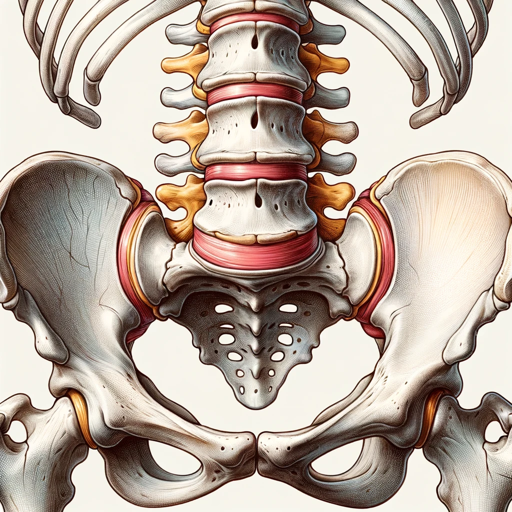Spinal adaptation for low back pain-spinal adaptation for back pain relief.
AI-powered spinal adaptation for back pain.
What is spinal adaptation and 6 movements to increase blood circulation and nutrition and help spinal adaptation
How to avoid back surgery with understanding spinal adaptation adapt muscles, ligaments, disc, joints and bones with 6 movements
Spinal adaptation occurred in the back muscles, ligaments, disc, joints, nerves and bones
You should understand amazing spinal adaptation like all human beings other adaptaition.
Related Tools
Load More
The Physio Assistant
Hospital and Primary Care Physiotherapy Assistant

Physical Therapy
Provides information on physical therapy and exercises.

Orthopedic Expert
Your go-to AI for comprehensive orthopedic care, occupational health, and tailored nutrition.

Biomechanics of Human Movement Tutor
Expert in biomechanics, aiding graduate students with detailed, research-backed answers.

Low Back Pain
1. Pain indicate that cells in your back is dead, damaged and weak. 2. Blood circulation and nutrition are crucial to back. 3. Very simple 6 movements to increase blood circulation to back. 4. Spinal adaptation. 5. Redlight stretch by M.D

Occupational Therapist Expert GPT
A robust assistant for OTs creating patient-focused plans.
20.0 / 5 (200 votes)
Understanding Spinal Adaptation for Low Back Pain
Spinal adaptation refers to the body's natural response to stress, injury, or degeneration in the structures of the spine, such as muscles, ligaments, discs, joints, nerves, and bones. When back pain occurs, it's often a result of these structures becoming weak, damaged, or compromised. Over time, the body tries to adapt by compensating for areas of weakness, leading to postural changes, stiffness, or imbalances. This adaptation can sometimes cause more harm than good, creating chronic pain or worsening the original issue. The goal of spinal adaptation for low back pain is to encourage proper movement, improve blood flow, and restore function to weakened or injured areas by focusing on six key movements: flexion, extension, right and left lateral flexion, and right and left rotation. These movements stimulate circulation and promote healing by enhancing oxygen and nutrient delivery to the cells in the spine. For example, after sitting for long hours, the muscles and joints can become stiff, leading to pain. Regular stretching and movements can help alleviate this discomfort, prevent further damage, and support long-term spinal health.

Key Functions of Spinal Adaptation for Low Back Pain
Improving Blood Circulation
Example
Performing regular stretches during breaks in long-distance driving can increase blood flow to the spine, preventing stiffness and pain.
Scenario
A truck driver experiencing back pain due to long hours behind the wheel can use the six spinal movements (flexion, extension, right and left lateral flexion, right and left rotation) at each red light. This keeps blood flowing to the muscles and joints, reducing pain and discomfort.
Strengthening Weak or Damaged Cells
Example
Daily spinal movements promote healing by delivering oxygen and nutrients to weakened areas, encouraging cell repair and regeneration.
Scenario
Someone recovering from a back injury can use these movements to strengthen the spine over time. For example, gentle lateral flexion (side bends) helps stretch and strengthen the muscles around the spine without causing further injury.
Preventing Further Spinal Deterioration
Example
Regular movement can stop the progression of spinal degeneration by maintaining flexibility and mobility in the joints and discs.
Scenario
A desk worker sitting for prolonged periods can prevent stiffness and spinal degeneration by performing the six movements during breaks. This helps avoid the buildup of pressure on the spine, which can lead to chronic pain or further injury.
Target Users for Spinal Adaptation Services
Long-Distance Drivers
These users often sit for extended periods, which reduces blood circulation to the spine and increases the risk of stiffness and pain. They can greatly benefit from incorporating the six spinal movements into their routine, particularly during red light stops, to improve blood flow and prevent pain caused by prolonged immobility.
Office Workers and Sedentary Individuals
People who sit for most of the day, such as office workers, are prone to poor circulation and muscle weakening in the back. This group benefits from spinal adaptation movements that prevent stiffness and promote blood flow, reducing the risk of developing chronic back pain.

Guidelines for Using Spinal Adaptation for Low Back Pain
Visit aichatonline.org for a free trial
Access the service at aichatonline.org where you can try it for free without the need to login or subscribe to ChatGPT Plus. Start by familiarizing yourself with the platform and the resources available for spinal adaptation.
Understand the six foundational movements
Learn the six key spinal movements—flexion, extension, right/left lateral flexion, and right/left rotation. These movements improve blood circulation, targeting weak and damaged cells in muscles, ligaments, discs, and joints.
Perform stretches regularly
Incorporate these movements during red light stretches while driving or in breaks throughout the day. Start with gentle motions, ensuring no pain, and gradually increase repetitions for better blood flow.
Monitor progress and adapt
Track improvements in flexibility, pain levels, and mobility. If discomfort occurs, reduce intensity, but remain consistent to allow the body to adapt and repair.
Consult the tool for personalized advice
Use the tool's advice on spinal exercises based on your needs. Whether you're recovering from an injury or improving posture, adjust the recommendations for your specific pain and range of motion.
Try other advanced and practical GPTs
Low Voltage Sales Assistant
AI-powered assistant for low voltage sales.

Low Back Pain
AI-powered back pain relief and prevention

Penetration testing GPT
AI-Powered Penetration Testing Assistant

Software Testing Assistant [Manual/Automation]
AI-powered tool for software testing.
![Software Testing Assistant [Manual/Automation]](https://files.oaiusercontent.com/file-MlYx58XvLrh7G8RFtIM8SNTn?se=2123-12-26T08%3A59%3A12Z&sp=r&sv=2021-08-06&sr=b&rscc=max-age%3D1209600%2C%20immutable&rscd=attachment%3B%20filename%3Dad.png&sig=w6C5QHYeFxCuVqjVv0R2TmlWio9JklIb0B5ozQvBOrQ%3D)
Automated Image Prompt Variation Testing
AI-powered image prompt generation

Heat Transfer Problem Solver
AI-powered Heat Transfer Analysis

VS Code
AI-powered coding for everyone.

VS GPT 5
AI-powered tool for smarter tasks

Ideal Client Profile Architect
AI-powered tool to define your ideal customer.

Client Email Assistant For Lawyers
AI-powered professional email drafting.

Industrial Design Sketch Assistant
AI-powered Industrial Design Sketches

Adult Coloring Book Hero
AI-powered custom coloring designs

- Chronic Pain
- Posture Correction
- Injury Recovery
- Driving Stretches
- Desk Work
Q&A about Spinal Adaptation for Low Back Pain
How do these six spinal movements help with back pain?
The six movements (flexion, extension, lateral flexion, and rotation) help restore blood flow to areas in the spine where cells in muscles, ligaments, discs, and joints have weakened or died. This increased circulation helps nourish these areas, promoting repair and reducing pain.
Can I perform these stretches during daily activities?
Yes, red light stretches are an effective way to perform these movements during everyday tasks, like when you're driving. A 60-90 second stretch at a stoplight can make a significant difference in improving blood flow and relieving tension in the back.
What if I feel pain during the exercises?
You should perform these movements gently and without pain. If pain occurs, decrease intensity or the range of motion. The goal is to gradually improve mobility and blood circulation without causing strain or injury.
Why is blood circulation so important in relieving back pain?
Poor blood circulation is often a key factor in back pain because it deprives the spinal structures—muscles, discs, joints, and nerves—of the nutrients and oxygen needed for repair. Increasing circulation through specific movements helps regenerate damaged tissues.
How long does it take to see improvement?
Consistency is key. Some people may notice improvement in a few weeks, while others might need more time. Regular performance of the six movements will help the body adapt, strengthen weak areas, and reduce pain over time.